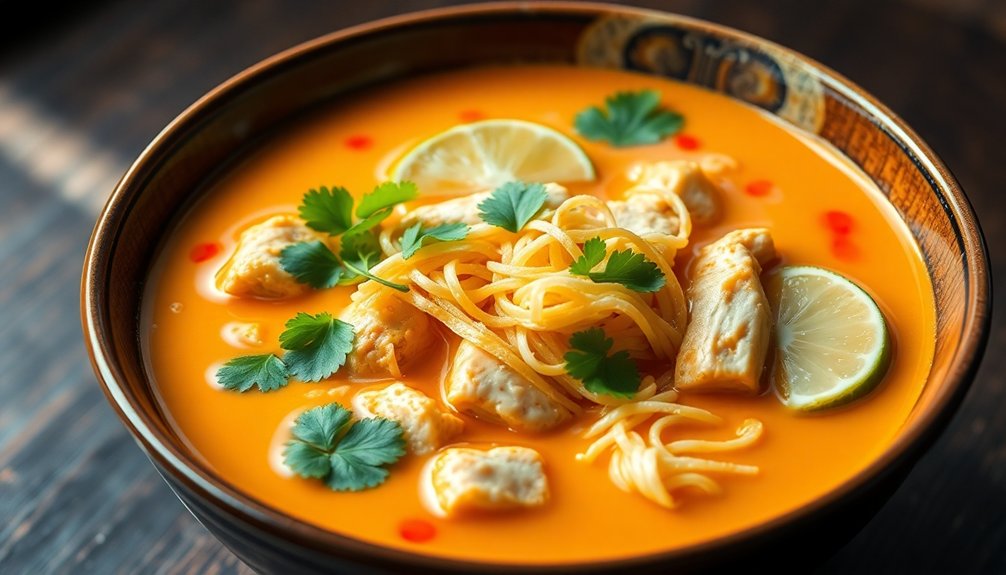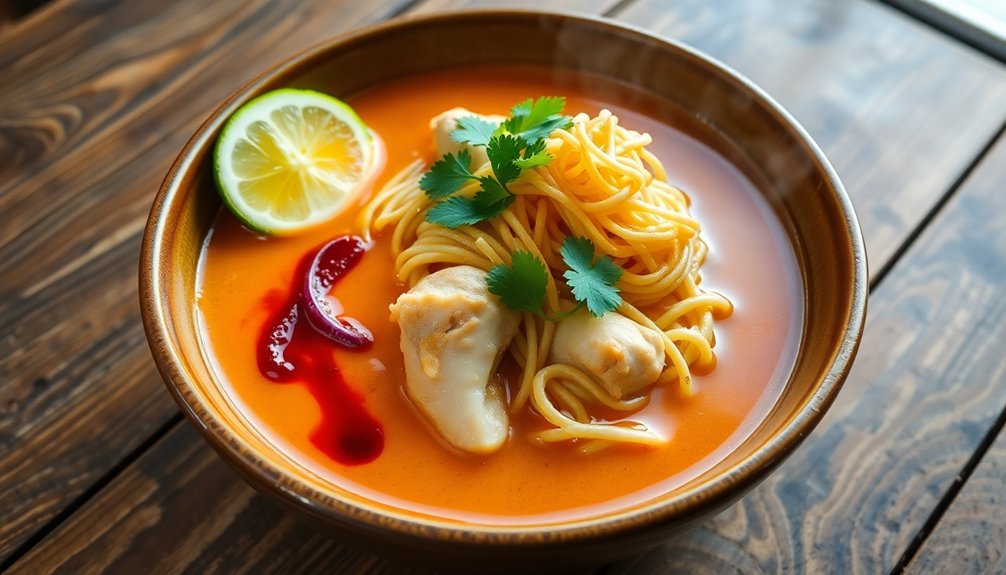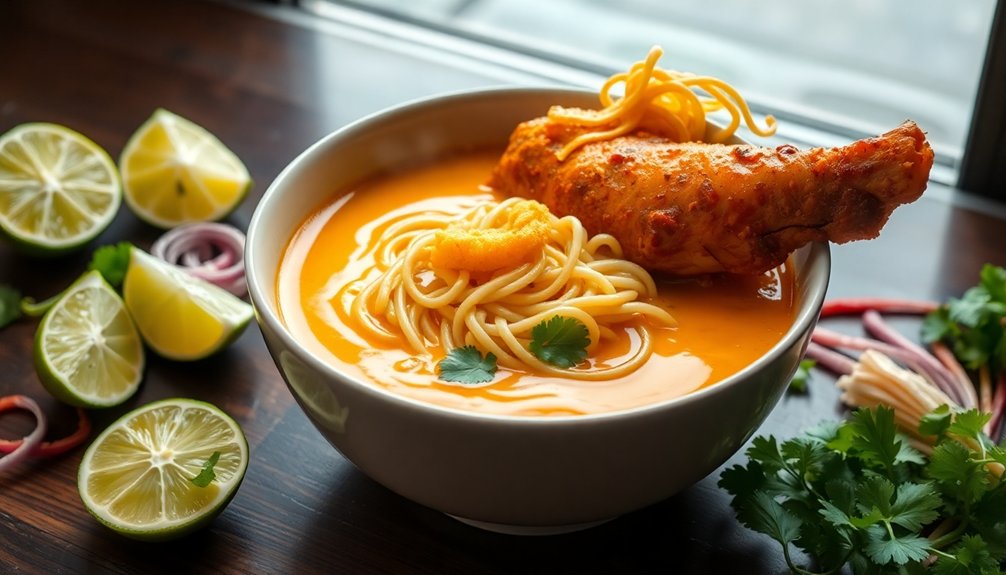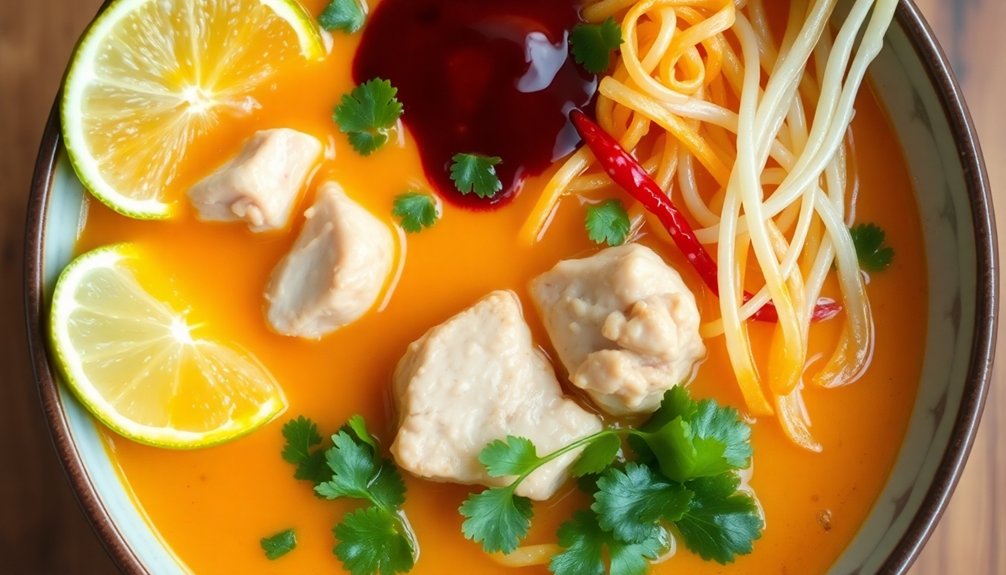You’ll create this iconic Northern Thai dish by blending aromatic curry paste with coconut milk, chicken stock, and tender chicken thighs. Cook egg noodles until al dente, then fry a portion until crispy for garnish. Combine the rich curry soup with soft noodles, topping with crispy noodles, lime wedges, shallots, and pickled mustard greens. Master this beloved Chiang Mai specialty, and you’ll reveal centuries of culinary tradition in every bowl.
Key Takeaways
- Blend dried chilies, shallots, garlic, ginger, turmeric, coriander seeds, cumin seeds, and shrimp paste to make the curry paste.
- Simmer curry paste with coconut milk and chicken stock, then add chicken thighs, palm sugar, and fish sauce.
- Cook egg noodles until tender, and separately fry a portion until crispy for the essential textural contrast.
- Top soup with crispy noodles, lime wedges, pickled mustard greens, fresh cilantro, and chili oil for authentic garnish.
- Maintain a gentle simmer when cooking curry to prevent coconut milk separation and ensure chicken remains tender.

History

Though its exact origins are debated, Khao Soi emerged from the intersection of Chinese Muslim and Burmese influences in Northern Thailand during the 19th century. This beloved dish showcases the cultural significance of the ancient trade routes through Southeast Asia, particularly in Chiang Mai where it’s become an iconic street food.
- Chinese Muslim traders brought wheat noodles and their culinary techniques along the Silk Road.
- Burmese influences contributed the curry-based broth and coconut milk elements.
- Thai cooks adapted the recipe using local ingredients and spices.
- Regional variations emerged across Northern Thailand, with each area adding its own twist.
Today, you’ll find Khao Soi’s rich heritage reflected in its complex flavors, making it one of Thailand’s most celebrated dishes.

Recipe
Ingredients:
For the curry paste:
- 6 dried red chilies, soaked and drained
- 2 shallots, chopped
- 4 garlic cloves
- 2-inch piece ginger, chopped
- 2 tablespoons turmeric powder
- 1 tablespoon coriander seeds
- 1 teaspoon cumin seeds
- 2 tablespoons shrimp paste
For the soup:
- 2 cans (14 oz each) coconut milk
- 2 cups chicken stock
- 2 pounds chicken thighs, cut into chunks
- 2 tablespoons palm sugar
- 2 tablespoons fish sauce
- 1 pound egg noodles
- Oil for frying
For garnish:
- Crispy egg noodles
- Lime wedges
- Shallots, thinly sliced
- Pickled mustard greens
- Fresh cilantro
- Chili oil
Instructions:
- Toast coriander and cumin seeds in a dry pan until fragrant. Grind in a spice grinder.
- Blend curry paste ingredients in a food processor until smooth.
- Heat oil in a large pot. Fry curry paste for 2-3 minutes until fragrant.
- Add coconut milk and chicken stock. Bring to a simmer.
- Add chicken, palm sugar, and fish sauce. Simmer for 30 minutes.
- Meanwhile, fry some egg noodles until crispy for garnish.
- Cook remaining egg noodles according to package instructions.
- Place cooked noodles in bowls, ladle curry soup over them.
- Top with crispy noodles, lime wedges, shallots, pickled greens, cilantro, and chili oil.
Cooking Steps

You’ll begin by toasting your whole spices in a dry pan until they release their aromatic oils before grinding them with fresh ingredients to create a vibrant curry paste.
Next, you’ll simmer this paste with coconut milk until it thickens and develops deep flavors, while simultaneously cooking your egg noodles in a separate pot until they reach the perfect tender consistency.
Finally, you’ll take a portion of those noodles and fry them until crispy, creating the signature contrasting textures that make khao soi gai so memorable.
Step 1. Toast Spices Until Fragrant
Toasting the spices releases their essential oils and intensifies the complex flavors that make khao soi so distinctive. You’ll notice the spice aroma fills your kitchen as you heat them in a dry skillet over medium heat. For peak flavor enhancement, toast your whole spices until they become deeply fragrant, usually 3-4 minutes.
- Shake the pan continuously to prevent burning and guarantee even toasting
- Watch for visual cues – spices will darken slightly and become more aromatic
- Remove from heat immediately when fragrant to avoid scorching
- Let them cool completely before grinding to a fine powder
Once toasted, your spices will transform the curry paste into a rich, complex base that defines authentic khao soi‘s signature taste.
The toasting process awakens dormant flavors that simply can’t be achieved with pre-ground spices.
Step 2. Blend Curry Paste Ingredients
Blending the curry paste ingredients requires careful attention to create the silky-smooth texture that’s essential for authentic khao soi.
Place your toasted spices in a high-powered blender or food processor, then add the fresh aromatics: lemongrass, galangal, garlic, shallots, and Thai chilies. You’ll want to pulse these ingredients first before blending continuously.
Add the soaked dried chilies, shrimp paste, and turmeric to the mixture. Monitor the ingredient proportions carefully – too much of any single element can overpower the curry paste’s balanced flavor profile.
Blend until you achieve a fine, uniform consistency, scraping down the sides as needed. The finished curry paste should be smooth enough to dissolve easily in coconut milk without any graininess.
Step 3. Simmer Curry With Coconut Milk
Once the curry paste is ready, heat vegetable oil in a large pot over medium heat until it shimmers.
Add your curry paste and fry it for 2-3 minutes until fragrant, stirring constantly to prevent burning. The paste will release its rich flavors as it cooks.
- Pour in the thick coconut cream first and stir continuously until the oil begins to separate.
- Add the remaining coconut milk and bring to a gentle simmer.
- Lower heat and let it cook for 10 minutes, allowing the curry to develop its complex flavors.
- If the sauce becomes too thick, thin it with a splash of chicken stock.
Keep stirring occasionally as the curry simmers, ensuring the coconut milk doesn’t split.
You’ll know it’s ready when the sauce is smooth and aromatic, with oil glistening on the surface.
Step 4. Boil Egg Noodles Until Tender
While your curry simmers, it’s time to prepare the egg noodles – the heart of any great khao soi.
Bring a large pot of water to a rolling boil and add your fresh egg noodles. If you’re using dried noodles, follow the package instructions for cooking time, but fresh noodles typically need only 2-3 minutes until tender.
Don’t overcook the noodles – you want them al dente with a slight chew. Test a noodle by biting into it to check the texture.
Once they’re done, drain them immediately in a colander and rinse briefly with cold water to stop the cooking process. This prevents them from becoming mushy and helps maintain their springy texture.
Set aside a portion of the noodles for frying later as a crispy topping.
Step 5. Fry Noodles Until Crispy
Heat vegetable oil in a wok or deep skillet to 350°F (175°C) – you’ll need enough oil to submerge the noodles.
Take your reserved uncooked egg noodles and carefully drop them into the hot oil in small batches. These crispy noodles will create the signature topping that makes khao soi so distinctive.
- Watch as the noodles immediately puff up and turn golden brown – this should take about 30 seconds.
- Use a spider strainer or slotted spoon to quickly remove the noodles once they reach a crispy texture.
- Place fried noodles on paper towels to drain excess oil and maintain crispiness.
If using different noodle types, like rice noodles, adjust frying time as they cook faster than egg noodles.
Keep these fried noodles separate until serving – they’ll add the perfect crunch to your khao soi.
Cooking Tips

Success with khao soi gai relies on careful temperature control during cooking.
You’ll need to maintain a gentle simmer when cooking the curry, never letting it reach a rolling boil that could cause the coconut milk to separate.
Watch the heat closely when frying the crispy noodles – they’ll brown quickly and can burn in seconds.
For the best cooking techniques, toast your curry paste before adding coconut milk to intensify the flavors.
If you can’t find certain ingredients, there are workable ingredient substitutions: substitute regular curry powder for Madras curry powder, or use dried egg noodles instead of fresh ones.
When cooking the chicken, make certain it’s fully submerged in the curry sauce to prevent it from drying out and to absorb maximum flavor.
Final Thoughts

Creating khao soi gai at home brings the vibrant flavors of Northern Thailand right to your kitchen. This rich, coconut curry noodle soup holds deep cultural significance in Chiang Mai’s culinary heritage.
As you savor each spoonful, you’ll understand why this dish has captivated food lovers worldwide.
- The contrast between crispy and soft noodles creates an unforgettable textural experience
- Making your own curry paste connects you to authentic Thai cooking traditions
- The dish’s complexity allows for personal adjustments to heat and flavor profiles
- Each bowl tells the story of Northern Thailand’s diverse cultural influences
Master this recipe, and you’ll have a signature dish that impresses guests and transports you to the bustling streets of Northern Thailand whenever you crave those bold, aromatic flavors.
Frequently Asked Questions
What Can I Substitute for Coconut Milk if I’m Allergic?
You’ll find silky almond milk or creamy soy milk makes a delicious dairy-free substitute. While slightly thinner than coconut milk, they’ll still give your curry that smooth, rich texture you’re craving.
How Long Will Leftover Khao Soi Stay Fresh in the Refrigerator?
You’ll get 3-4 days of leftover storage if you keep it refrigerated in an airtight container. Watch for spoilage signs like sour smell or separation. Don’t store noodles with the broth.
Is There a Vegetarian Version of Khao Soi?
You can make delicious vegetarian khao soi by substituting chicken with crispy tofu, mushrooms, or tempeh. Many vegetarian alternatives work well while maintaining the curry’s rich, coconut-based flavor profile.
Where Can I Find Palm Sugar if My Local Store Doesn’t Stock It?
You’ll find palm sugar at Asian specialty stores or well-stocked international markets. If those aren’t nearby, try online grocery retailers like Amazon or Asian food websites that ship nationwide.
Can I Prepare the Curry Paste in Advance and Freeze It?
Fresh as the morning dew, your curry paste will keep beautifully in the freezer for up to 3 months. Store it in small portions using airtight containers or ice cube trays.
